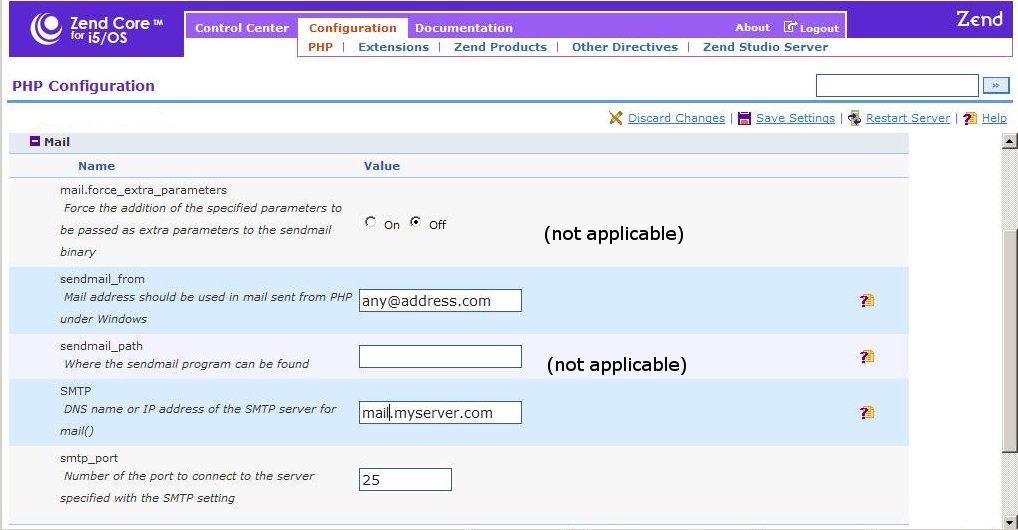PHP, the popular Web development language, has long provided a built-in function, mail(), to send email messages. Until recently, this function was available only on non-System i platforms. The limitation applied both to home-grown System i PHP versions and to beta releases of Zend Core for i5/OS (the PHP distribution by IBM and Zend).
Users of PHP on System i can now rejoice. The GA release of Zend Core for i5/OS, introduced in August 2006, implements mail().
Why Is mail() Necessary?
Although alternatives such as PHPMailer provide ample features, these substitutes take more effort to set up. More important, some software packages are programmed to use mail() and will not operate without it.
Implementation on System i
Most UNIX systems contain a sendmail program. The mail() function takes advantage of this by sending messages through sendmail. On systems lacking sendmail, such as Windows and System i, Simple Mail Transfer Protocol (SMTP) does the job.
Function Definition and Example
The mail() function takes four parameters:
- To—Recipient's address
- Subject—Subject of the message
- Message—Message body
- Headers—Optional catch-all parameter, responsible for most other message settings, including the sender's email address ("From:") and any special encoding. When messages contain attachments or HTML, this parameter can become complex.
All four parameters are shown in this short PHP program:
Configuration
PHP.INI contains default mail settings. It can be found at /usr/local/zend/Core/etc/php.ini.
PHP.INI has three mail settings:
- SMTP—Name of an SMTP server, such as System i's included SMTP service, to send mail through (e.g., mail.myserver.com)
- smtp_port—Port number used by SMTP server (default: 25)
- Sendmail_from (optional)—Default "from" email address to use when mail()'s "headers" parameter does not specify one. Any address can be used. The server does not check its validity (e.g.,
any@address.com ). Note: Although messages are not required to be "from' anyone, messages lacking a "from" address may be seen as spam.
The three settings appear in PHP.INI under [mail function] like this:
[mail function]
SMTP=mail.myserver.com
smtp_port = 25
sendmail_from =
To change these settings, either edit the INI directly or use Zend Core's Web-based administration console.
The EDTF (Edit File) command allows editing of PHP.INI from a command line:
EDTF /usr/local/zend/Core/etc/php.ini
A PC-based text editor will also work, given adequate authority to PHP.INI.
Zend Core provides a Web-based control panel to edit these settings, located at
http://www.domain.com:8000/ZendCore/ (where www.domain.com is the appropriate domain name) on the PHP Configuration page (Figure 1).

Figure 1: The PHP Configuration page allows editing of sendmail_from, SMTP, and smtp_port. (Click image to enlarge.)
Changes to PHP.INI will take effect after the Apache server is restarted. Apache can be restarted with the Restart Server link in the Web interface and with Zend Core's Apache menu: GO ZENDCORE/ZCAMENU.
Set Options Dynamically with ini_set()
PHP's ini_set() function temporarily sets a given configuration option. Ideal for altering options dynamically, and in installations unable to change PHP.INI, ini_set() affects options for the duration of the program that invoked it.
ini_set() takes two parameters:
- Varname—Variable/option to change
- Newvalue—Value to change to
The following lines of code show how to set the SMTP server and "from" address within a PHP function.
ini_set("SMTP","mail.domain.com"); // note: “SMTP” must be upper case.
ini_set("sendmail_from","
Troubleshooting
If mail() does not work as expected, clues may be found in PHP's error log:
/usr/local/zend/Core/logs/php_error_log
The error log may be viewed with a text editor or this command:
DSPF '/usr/local/zend/Core/logs/php_error_log'
mail() vs. Alternatives
As mentioned earlier, mail() is not the only way to send mail in PHP. Fuller-featured alternatives include the following:
• PHPMailer
• PHP Extension and Application Repository (PEAR) Mail (recommended by the official mail() function page for sending HTML or complex emails)
Advantages of mail():
- It's included with PHP; no installation and little configuration needed.
- One line of code is sufficient to send a simple message.
- Many prominent software packages, such as WordPress blog software, depend on mail(), which is not an advantage per se, but it's a reason to have it available.
Advantages of the alternatives:
- Support for SMTP authentication, which is absent in mail(). In SMTP authentication, a mail client proves its identity to an SMTP server with a user ID and password. Many SMTP servers, such as Lotus Domino's, can be configured to demand authentication to deter unauthorized use.
- Programmers need not understand mail headers. Complex messages and attachments are handled easily, without complicated header strings.
An Invaluable Tool
The mail() function works well for relatively simple email tasks. Its hidden strength, though, is in the many software packages that use it. With the GA release of Zend Core, System i gets the power to host an expanded universe of commercial and open-source applications written in PHP.
Resources
• www.php.net/mail
• http://us2.php.net/manual/en/function.mail.php
• Security Considerations for mail()
• Zend Brings PHP to IBM's i5/OS (article by this author; introduction to PHP on System i)
• Main page, Zend for i5/OS












 IT managers hoping to find new IBM i talent are discovering that the pool of experienced RPG programmers and operators or administrators with intimate knowledge of the operating system and the applications that run on it is small. This begs the question: How will you manage the platform that supports such a big part of your business? This guide offers strategies and software suggestions to help you plan IT staffing and resources and smooth the transition after your AS/400 talent retires. Read on to learn:
IT managers hoping to find new IBM i talent are discovering that the pool of experienced RPG programmers and operators or administrators with intimate knowledge of the operating system and the applications that run on it is small. This begs the question: How will you manage the platform that supports such a big part of your business? This guide offers strategies and software suggestions to help you plan IT staffing and resources and smooth the transition after your AS/400 talent retires. Read on to learn: Business users want new applications now. Market and regulatory pressures require faster application updates and delivery into production. Your IBM i developers may be approaching retirement, and you see no sure way to fill their positions with experienced developers. In addition, you may be caught between maintaining your existing applications and the uncertainty of moving to something new.
Business users want new applications now. Market and regulatory pressures require faster application updates and delivery into production. Your IBM i developers may be approaching retirement, and you see no sure way to fill their positions with experienced developers. In addition, you may be caught between maintaining your existing applications and the uncertainty of moving to something new.
LATEST COMMENTS
MC Press Online